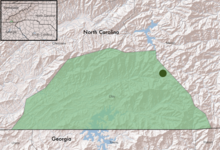| Symphyotrichum rhiannon | |
|---|---|

| |
| Conservation status | |
 Critically Imperiled (NatureServe) | |
| Scientific classification | |
| Kingdom: | Plantae |
| Clade: | Tracheophytes |
| Clade: | Angiosperms |
| Clade: | Eudicots |
| Clade: | Asterids |
| Order: | Asterales |
| Family: | Asteraceae |
| Tribe: | Astereae |
| Subtribe: | Symphyotrichinae |
| Genus: | Symphyotrichum |
| Subgenus: | Symphyotrichum subg. Symphyotrichum |
| Section: | Symphyotrichum sect. Symphyotrichum |
| Species: | S. rhiannon |
| Binomial name | |
| Symphyotrichum rhiannon Weakley & Govus | |

| |
| Endemic distribution | |
Symphyotrichum rhiannon is a species of flowering plant endemic to a serpentine barren in western North Carolina. It has been given the vernacular Rhiannon's aster and is also known as Buck Creek aster. It is a perennial, herbaceous plant in the family Asteraceae.
Description
Symphyotrichum rhiannon is a perennial flowering plant that grows between heights of 15 and 60 centimeters (5.9 and 23.6 inches). It forms colonies from thin, long rhizomes, and blooms from September into November with flower heads that have 18–32 blue to lavender ray florets and yellow disk florets.

Chromosomes
Symphyotrichum rhiannon has a base number of x = 8. Hexaploid cytotype with a chromosome count of 48 has been reported.
Taxonomy
Symphyotrichum rhiannon was formally described by Alan Stuart Weakley and Thomas E. Govus in 2004.

Etymology
Kauffman, Nesom, et al., formally explained the etymology of the species as follows:
is named in honor of Rhiannon Weakley, whose desire to rest during a field excursion led the authors to further investigate..., and also in honor of the original Rhiannon, a Welsh goddess figure....
Informally explained, Rhiannon Weakley was the toddler daughter of Alan and Allison Weakley. She needed a snack and a nap during the 2003 field excursion.
"Rhiannon hadn’t had a nap that morning," says Alan Weakley, "and she had a little, ah, loss of composure." So the group plopped down to give Rhiannon a snack and a chance to rest. And there, growing all around, was Mansberg's mystery aster.
Distribution and habitat
Symphyotrichum rhiannon is endemic to the Buck Creek Serpentine Barrens in Clay County, North Carolina, in the Nantahala National Forest.
Conservation
NatureServe lists it as Critically Imperiled (G1).
Citations
- ^ NatureServe (2021).
- POWO (2019).
- USDA, NRCS (2014).
- ^ Kauffman et al. (2004).
- Brouillet et al. (2006).
- Semple (2021).
- Semple (n.d.).
- Smith (2005).
- USFS (n.d.).
References
- Brouillet, L.; Semple, J.C.; Allen, G.A.; Chambers, K.L.; Sundberg, S.D. (2006). "Symphyotrichum rhiannon". In Flora of North America Editorial Committee (ed.). Flora of North America North of Mexico (FNA). Vol. 20. New York and Oxford: Oxford University Press. Retrieved 19 October 2024 – via eFloras.org, Missouri Botanical Garden, St. Louis, MO & Harvard University Herbaria, Cambridge, MA.
- Kauffman, G.L.; Nesom, G.L.; Weakley, A.S.; Govus, T.E.; Cotterman, L.M. (2004). "A new species of Symphyotrichum (Asteraceae: Astereae) from a serpentine barren in western North Carolina". SIDA, Contributions to Botany. 21: 827–839. ISSN 0036-1488. Retrieved 8 September 2021 – via Biodiversity Heritage Library.
- NatureServe (4 June 2021). "Symphyotrichum rhiannon – Rhiannon's Aster". NatureServe. Retrieved 21 June 2021.
- POWO (2019). "Symphyotrichum rhiannon Weakley & Govus". Plants of the World Online. Royal Botanic Gardens, Kew. Retrieved 21 June 2021.
- Semple, J.C. (n.d.). "Symphyotrichum rhiannon Rhiannon's Aster". www.uwaterloo.ca. Ontario. Archived from the original on 23 August 2021. Retrieved 8 September 2021.
- Semple, J.C. (1 May 2021). "Symphyotrichum subsect. Symphyotrichum Punicei Asters". www.uwaterloo.ca. Ontario. Archived from the original on 23 August 2021. Retrieved 8 September 2021.
- Smith, J. (1 September 2005). "Rhiannon's aster – a toddler's tantrum helps a new flower get its name". Endeavors (endeavors.unc.edu) (Fall 2005 ed.). Chapel Hill, North Carolina: UNC Research. ISSN 1933-4338. Archived from the original on 16 February 2012. Retrieved 29 November 2020.
- USDA, NRCS (2014). "Symphyotrichum rhiannon". USDA PLANTS Database (plants.usda.gov). United States Department of Agriculture (USDA). Retrieved 8 September 2021.
- USFS (n.d.). "Restoration of Buck Creek Serpentine Barrens, Tusquitee Ranger District, Nantahala National Forest". www.fs.fed.us. United States Forest Service, USDA. Archived from the original on 10 December 2020. Retrieved 29 November 2020.